2. 河北医科大学临床医学, 河北 石家庄 050000
2. Clinical College of Hebei Medical University, Shijiazhuang 050000, China
医院感染(healthcare-associated infection, HAI)不仅延长患者的住院时间,增加疾病的病死率,同时给家庭和社会带来严重的经济负担[1]。随着医疗技术的不断发展和抗菌药物广泛应用, 医院感染风险呈现多样化, 医院感染问题愈加突出, 成为当今医疗机构面临的重大挑战[2-4]。为了解全市医疗机构医院感染管理的现状,掌握医院感染监测指标,邢台市医院感染质控中心受邢台市卫生健康委委托,连续6年对全市50所二级及以上医院进行医院感染监测数据调查,比较医院感染监测指标变化趋势及不同级别医院之间的医院感染水平及质控情况,为完善全市医院感染防控工作提供依据。
1 对象与方法 1.1 调查对象2017—2022年邢台市二级及以上医院50所,包含专科医院和综合医院。
1.2 调查方法调查医院均按照WS/T 312—2009 《医院感染监测规范》《医疗机构住院患者感染监测基本数据集及质量控制指标集实施指南(2021版)》《医院感染管理信息系统基本功能规范》[5-7]的要求开展医院感染监测。根据监测定义,各医疗机构统计2017—2022年各年度的医院感染相关数据,由于全市未采用统一的医院感染实时监测系统,故调查均使用结果类数据,市医院感染管理质控中心每年发放调查表,收集全市二级及以上医疗机构医院感染管理工作基本指标及医院感染管理质量控制指标,受调查医院医院感染专职人员填报医院基本情况、人员组织体系、信息化建设、全年医院感染质量控制指标数据的分子和分母,计算医院感染发病率、医院感染现患率、医务人员手卫生依从率、Ⅰ类切口手术部位感染率、器械相关感染发病率等,医院感染管理质控中心对医院感染专职人员数据监测及上报流程进行培训,并审核、录入、汇总、统计分析上报数据,形成分析报告反馈上级卫生行政部门和各参与医疗机构。
1.3 统计分析全部调查资料经认真核实后,录入Excel,应用SPSS 26.0进行统计分析,计数资料以例数和百分比表示,率的比较采用χ2检验,以P≤0.05为差异有统计学意义。
2 结果 2.1 50所医院基本情况参与调查的50所医院中三级医院8所,二级医院42所;综合医院45所,专科医院5所。见表 1。在50所医院中,4所医院住院床位数<100张,其余46所医院床位数≥100张,均设立医院感染管理委员会,医院感染管理专职人员数量由2017年的91人增加至2022年的165人,医院信息化建设方面,医院感染管理软件使用率由2017年的17.00%上升至2022年的54.00%。
| 表 1 参与医院感染监测的50所医院基本情况 Table 1 Basic information of 50 hospitals participating in healthcare-associated infection monitoring |
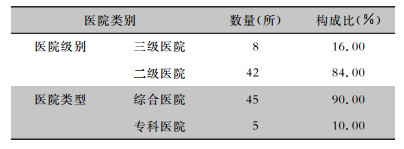
|
2017—2022年住院患者共4 404 181例,发生医院感染35 046例,医院感染发病率为0.80%,经趋势卡方检验,2017—2022年医院感染发病率整体呈下降趋势(Z=365 775.318,P < 0.001)。见表 2。
| 表 2 2017—2022年50所医院医院感染情况 Table 2 Healthcare-associated infection in 50 hospitals, 2017-2022 |
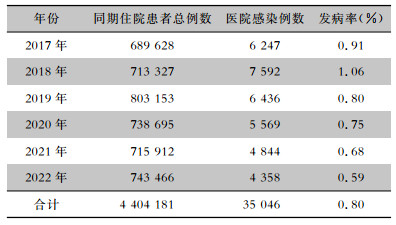
|
2017—2022年监测的住院患者共92 739例,医院感染例数1 689,医院感染现患率为1.82%,经趋势卡方检验,2017—2022年医院感染现患率整体呈下降趋势(Z=89.841,P < 0.001),由2.36%降至1.08%。见表 3。
| 表 3 2017—2022年50所医院医院感染现患情况 Table 3 Prevalence of healthcare-associated infection in 50 hospitals, 2017-2022 |
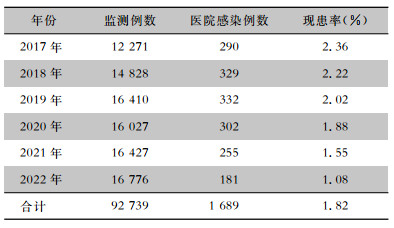
|
2017—2022年调查手卫生应执行时机数为674 413次,手卫生执行时机数526 929次,医务人员平均手卫生依从率为78.13%,经趋势卡方检验,2017—2022年医务人员手卫生依从率整体呈上升趋势(Z=20 626.832,P<0.001),由61.03%升高至85.04%。见表 4。
| 表 4 2017—2022年50所医院医务人员手卫生依从情况 Table 4 Hand hygiene compliance of health care workers in 50 hospitals, 2017-2022 |

|
2017—2022年接受Ⅰ类切口手术患者总数为347 488例,发生Ⅰ类切口手术部位感染808例,Ⅰ类切口手术部位感染率为0.23%,经趋势卡方检验,2017—2022年Ⅰ类切口手术部位感染率整体呈下降趋势(Z=31.661,P < 0.001),由0.33%降至0.16%。见表 5。
| 表 5 2017—2022年50所医院患者Ⅰ类切口手术部位感染情况 Table 5 Surgical site infection of class Ⅰ incision in 50 hospitals, 2017-2022 |
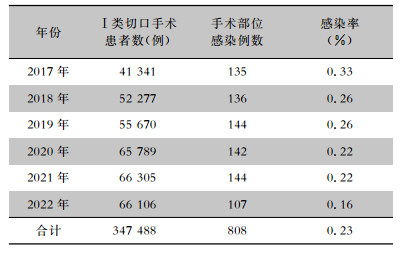
|
2017—2022年监测患者血管导管置管总日数为395 506 d,血管导管相关血流感染发病例次数180次,血管导管相关血流感染发病率为0.46‰;共使用有创呼吸机总日数144 680 d,呼吸机相关肺炎发病例次数为1 035次,呼吸机相关肺炎发病率为7.15‰,由13.78‰降至4.06‰;共留置导尿管总日数809 968 d,导尿管相关尿路感染例次数为1 121次,导尿管相关尿路感染发病率为1.38‰。2017—2022年3组器械相关感染发病率各组比较, 经趋势卡方检验,差异均有统计学意义(Z值分别为6.057、182.751、4.427,均P < 0.05)。见表 6。
| 表 6 2017—2022年50所医院器械相关感染情况 Table 6 Device-related infection in 50 hospitals, 2017-2022 |
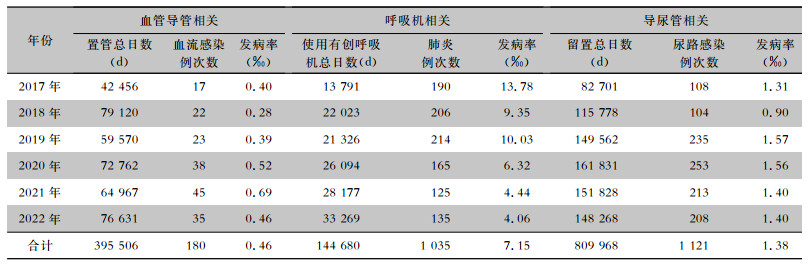
|
三级医院的医院感染发病率、医院感染现患率、医务人员手卫生依从率、呼吸机相关肺炎发病率均高于二级医院,二级医院的Ⅰ类切口手术部位感染率高于三级医院,差异均有统计学意义(均P<0.001)。
| 表 7 不同级别医院医院感染监测指标比较 Table 7 Comparison of healthcare-associated infection monitoring indexes in different grades of hospitals |

|
医院感染监测是医院感染管理工作的基础, 通过医院感染监测可以真实准确地反映不同区域、级别医疗机构的医院感染防控实践现状与管理风险[8]。近年来全国各医疗机构大力加强医院感染管理工作,尤其是在新型冠状病毒感染疫情期间,无论是在人力、财力、监测软件配备方面都加大了投入,对感染管理团队的结构及配备情况越来越重视,并开展了大量相关调查[9-10]。本次全市调查数据显示,2017—2022年医院感染专职人员数量有显著的增长,与相关研究[11]结果一致。
我国医院感染管理起步晚,但是发展迅速,尤其是医院感染监测方面,实时监测信息系统发挥了巨大作用,为医院感染管理质量控制工作的改善提供了革命性的工具。2015年国家卫生行政部门下发了《医院感染管理质量控制指标(2015年版)》,收集各级医院医院感染监测数据进行统计分析。全国各所医院均在发展或改进医院感染监测系统,利用对患者住院期间的全过程监测,提高医院感染病例监测和实施干预措施的及时性,统一医院感染监测数据采集规范,提升感染监测数据的准确性和及时性,进一步提高医院感染管理水平[12]。
本组调查中,医院感染发病率连续6年均低于全国三级医院1.58%的医院感染发病率[13],且整体呈下降趋势,医院感染现患率也呈下降趋势,与国内外研究[14-15]结果一致,可能是由于医院感染管理工作愈加受到重视,感染管理专职队伍管理水平和能力不断提高[16],提示需更加重视医院感染病例监测与报告,加强医院感染管理,并反馈、分析、采取针对性的医院感染防控措施, 降低医院感染及医院感染暴发的风险。
本研究中Ⅰ类切口手术部位感染率(0.23%)低于一项国内研究[17]203所医院报道的1.03%, 且整体呈下降趋势,其中不同等级医院的Ⅰ类切口手术部位感染率差异有统计学意义,二级医院高于三级医院,考虑可能与不同级别医疗机构的诊疗条件, 收治患者病种, 感染防控措施落实差异等有关。
器械相关感染会增加患者的疾病负担和病死率[18-21]。本研究中血管导管相关血流感染发病率、呼吸机相关肺炎发病率、导尿管相关尿路感染发病率整体也呈下降趋势;血管导管相关血流感染发病率(0.46‰)、呼吸机相关肺炎发病率(7.15‰)以及导尿管相关尿路感染发病率(1.38‰)均低于国内研究[22]报道的1.04‰、6.81‰、1.99‰,且呼吸机相关肺炎发病率三级医院均高于二级医院,考虑与三级医院的患者疾病复杂、侵入性操作较多及个体因素差异等有关。本研究监测结果显示, 呼吸机相关肺炎发病率最高,考虑主要与高龄患者多、病情复杂、免疫功能较差等自身高危因素有关,其次与呼吸道侵袭性操作使得咳嗽反射减弱、诊疗相关操作等增加了感染风险有关。因此,需重点关注落实呼吸机集束化管理、及时评估拔管、声门下分泌物引流、手卫生、床头抬高、口腔护理等防控措施[23-24]。
医务人员手卫生依从率呈逐年上升趋势,且三级医院高于二级医院,尤其是经过新型冠状病毒感染疫情后,医务人员手卫生意识有了进一步提升。
连续6年的全市调查能够看出医院感染监测指标的变化趋势,能够为制定医院感染的预防与控制措施提供科学依据,本研究调查发现多数指标呈整体向好趋势,但仍需要持续改进,不断降低医院感染相关发病率,制定更为完善、有效的防控措施,降低感染发生率,提高医疗质量,确保患者安全。
利益冲突:所有作者均声明不存在利益冲突。
| [1] |
Schreiber PW, Sax H, Wolfensberger A, et al. The preventable proportion of healthcare-associated infections 2005-2016: systematic review and Meta-analysis[J]. Infect Control Hosp Epidemiol, 2018, 39(11): 1277-1295. DOI:10.1017/ice.2018.183 |
| [2] |
Kollef MH, Torres A, Shorr AF, et al. Nosocomial infection[J]. Crit Care Med, 2021, 49(2): 169-187. DOI:10.1097/CCM.0000000000004783 |
| [3] |
Cassini A, Högberg LD, Plachouras D, et al. Attributable deaths and disability-adjusted life-years caused by infections with antibiotic-resistant bacteria in the EU and the European Economic Area in 2015: a population-level modelling analysis[J]. Lancet Infect Dis, 2019, 19(1): 56-66. DOI:10.1016/S1473-3099(18)30605-4 |
| [4] |
Eyre DW. Infection prevention and control insights from a decade of pathogen whole-genome sequencing[J]. J Hosp Infect, 2022, 122: 180-186. DOI:10.1016/j.jhin.2022.01.024 |
| [5] |
吴睿, 靳晓霞. ICU患者医院感染目标性监测与影响因素分析[J]. 中华医院感染学杂志, 2017, 27(17): 4045-4048. Wu R, Jin XX. Targeted surveillance of ICU patients with nosocomial infections and influencing factors[J]. Chinese Journal of Nosocomiology, 2017, 27(17): 4045-4048. |
| [6] |
付强, 刘运喜, 霍瑞, 等. 医疗机构住院患者感染监测基本数据集及质量控制指标集实施指南(2021版)[M]. 北京: 人民卫生出版社, 2021: 106-264. Fu Q, Liu YX, Huo R, et al. Guidelines for the implementation of the basic data set and the quality control index set for in-patient infection surveillance in medical institutions (2021 edition)[M]. Beijing: People's Medical Publishing House, 2021: 106-264. |
| [7] |
中华人民共和国国家卫生和计划生育委员会. 医院感染管理信息系统基本功能规范: WS/T 547—2017[S]. 北京, 2017. National Health and Family Planning Commission. The basic function criterion of hospital infection management information system: WS/T 547-2017[S]. Beijing, 2017. |
| [8] |
宋晓超, 金钧, 乔美珍, 等. 苏州市41所医院区域性医院感染监测平台数据分析[J]. 中华医院感染学杂志, 2023, 33(9): 1413-1416. Song XC, Jin J, Qiao MZ, et al. Data from regional nosoco-mial infection monitoring platforms of 41 hospitals in Suzhou[J]. Chinese Journal of Nosocomiology, 2023, 33(9): 1413-1416. |
| [9] |
Pogorzelska-Maziarz M, Gilmartin H, Reese S. Infection prevention staffing and resources in U.S. acute care hospitals: results from the APIC MegaSurvey[J]. Am J Infect Control, 2018, 46(8): 852-857. DOI:10.1016/j.ajic.2018.04.202 |
| [10] |
Yoon YK, Lee SE, Seo BS, et al. Current status of personnel and infrastructure resources for infection prevention and control programs in the Republic of Korea: a national survey[J]. Am J Infect Control, 2016, 44(11): e189-e193. DOI:10.1016/j.ajic.2016.07.023 |
| [11] |
马文晖, 王力红, 赵会杰, 等. 北京市27所三级综合医院医院感染管理现况调查[J]. 中华医院感染学杂志, 2022, 32(16): 2533-2536. Ma WH, Wang LH, Zhao HJ, et al. Investigation on infection management in 27 tertiary general hospitals in Beijing[J]. Chinese Journal of Nosocomiology, 2022, 32(16): 2533-2536. |
| [12] |
赵烁, 付强, 刘运喜, 等. 统一数据采集规范的区域性医院感染管理信息体系建设[J]. 中华医院感染学杂志, 2016, 26(6): 1404-1406. Zhao S, Fu Q, Liu YX, et al. Regional nosocomial infections management information system construction based on unified specification of information data collection[J]. Chinese Journal of Nosocomiology, 2016, 26(6): 1404-1406. |
| [13] |
李六亿, 吴安华, 付强. 传承创新展望中国医院感染管理卅年(1986—2016)[M]. 北京: 北京大学医学出版社, 2016: 109. Li LY, Wu AH, Fu Q. Innovation, and outlook: China 30 years hospital infection management(1986-2016)[M]. Beijing: Peking University Medical Press, 2016: 109. |
| [14] |
Magill SS, O'Leary E, Janelle SJ, et al. Changes in prevalence of health care-associated infections in U.S. hospitals[J]. N Engl J Med, 2018, 379(18): 1732-1744. DOI:10.1056/NEJMoa1801550 |
| [15] |
吕林芳, 张汉阳, 周春莲. 2014—2018年某三甲医院医院感染监测数据分析[J]. 中国消毒学杂志, 2020, 37(5): 355-358. Lv LF, Zhang HY, Zhou CL. Analysis of surveillance data of nosocomial infections in a level A tertiary hospital from 2014 to 2018[J]. Chinese Journal of Disinfection, 2020, 37(5): 355-358. |
| [16] |
杨亚红, 张浩军, 朱腾飞, 等. 甘肃省44家医疗机构医院感染管理工作现状调查[J]. 中国护理管理, 2022, 22(2): 281-285. Yang YH, Zhang HJ, Zhu TF, et al. Current status of healthcare-associated infection control work in 44 hospitals in Gansu province[J]. Chinese Nursing Management, 2022, 22(2): 281-285. |
| [17] |
张磊, 唐婷, 杨滢, 等. 云南省203家医疗机构医院感染横断面调查分析[J]. 中国消毒学杂志, 2022, 39(6): 452-455, 460. Zhang L, Tang T, Yang Y, et al. A cross-sectional survey on healthcare-associated infection in 203 hospitals of Yunnan province[J]. Chinese Journal of Disinfection, 2022, 39(6): 452-455, 460. |
| [18] |
Bassetti M, Mularoni A, Giacobbe DR, et al. New antibiotics for hospital-acquired pneumonia and ventilator-associated pneumonia[J]. Semin Respir Crit Care Med, 2022, 43(2): 280-294. |
| [19] |
Selby LM, Rupp ME, Cawcutt KA. Prevention of central-line associated bloodstream infections: 2021 update[J]. Infect Dis Clin North Am, 2021, 35(4): 841-856. |
| [20] |
Clarke K, Hall CL, Wiley Z, et al. Catheter-associated urinary tract infections in adults: diagnosis, treatment, and prevention[J]. J Hosp Med, 2020, 15(9): 552-556. |
| [21] |
王志翔, 张会娟, 李怡, 等. 2017—2019年上海55所医院ICU导管相关性感染监测分析[J]. 中华医院感染学杂志, 2021, 31(18): 2864-2867. Wang ZX, Zhang HJ, Li Y, et al. Surveillance of catheter-related infection in ICUs of 55 hospitals in Shanghai from 2017 to 2019[J]. Chinese Journal of Nosocomiology, 2021, 31(18): 2864-2867. |
| [22] |
杨俊林, 查筑红, 杨昆, 等. 贵州省234所医疗机构医院感染相关指标调查[J]. 中国感染控制杂志, 2019, 18(11): 1038-1043. Yang JL, Zha ZH, Yang K, et al. Survey on relevant indexes of healthcare-associated infection in 234 medical institutions in Guizhou Province[J]. Chinese Journal of Infection Control, 2019, 18(11): 1038-1043. |
| [23] |
中华医学会呼吸病学分会感染学组. 中国成人医院获得性肺炎与呼吸机相关性肺炎诊断和治疗指南(2018年版)[J]. 中华结核和呼吸杂志, 2018, 41(4): 255-280. The Chinese medical association respiratory neurology, the infection group. Chinese adult hospital acquired pneumonia and ventilator associated pneumonia diagnosis and treatment guidelines (2018)[J]. Chinese Journal of Tuberculosis and Respiratory Diseases, 2018, 41(4): 255-280. |
| [24] |
Lotfinejad N, Peters A, Tartari E, et al. Hand hygiene in health care: 20 years of ongoing advances and perspectives[J]. Lancet Infect Dis, 2021, 21(8): e209-e221. |



